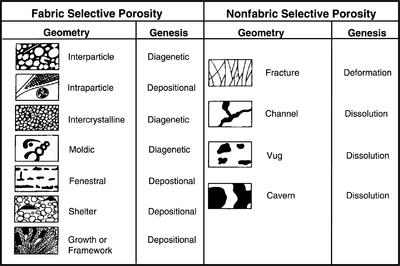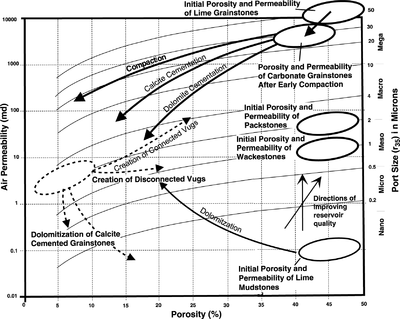Carbonate porosity formation and preservation
| Exploring for Oil and Gas Traps | |

| |
| Series | Treatise in Petroleum Geology |
|---|---|
| Part | Predicting the occurrence of oil and gas traps |
| Chapter | Predicting reservoir system quality and performance |
| Author | Dan J. Hartmann, Edward A. Beaumont |
| Link | Web page |
| Store | AAPG Store |
Early influences
How much influence does the original fabric of a carbonate rock (grains, mud, and pore space) have on with the pore space in the rock now? Which has more impact on reservoir quality of carbonates: early or late diagenesis? The interaction of early diagenesis with original fabric elements determines, in many cases, the ultimate reservoir quality of a carbonate. A rock that begins with good porosity and permeability, either from depositional or early diagenetic processes, has a better chance of retaining those qualities than an initially poor-quality rock becoming a good-quality rock. Porosity can be created late in a rock's life; however, concentrating on the early history of a carbonate rock is generally more rewarding when searching for reservoir-quality rocks.
Diagenesis and rock fabric

The initial solid constituents of a carbonate rock normally determine its initial pore type and geometry and strongly influence diagenesis. Early pore space in carbonate rocks generally has fabric-selective characteristics; creation of late pore space does not.[1] Surface and shallow diagenesis mainly occurs in fabric-selective pore geometries that allow the greatest fluid flow (mostly interparticle or intercrystalline). Late-stage shallow diagenesis mainly occurs in nonfabric-selective pore geometries that allow the greatest fluid flow (mostly fracture related). Deep diagenetic processes can be both fabric selective (fluid flow through interparticle or intercrystalline pores) or nonfabric selective (compaction).
Fabric and nonfabric selection porosity
Figure 1 shows fabric and nonfabric pore geometries and processes that create them.
Early diagenesis and pore-system quality
Figure 2 shows the general pathways that different carbonate rock types might take during early diagenesis as their pore systems evolve. The parallel lines are contours of equal pore throat size. In terms of quality, points plotting along the contours represent rocks with equal flow characteristics (see Characterizing rock quality). With the exception of the creation of connected vugs and dolomitized mudstone, carbonate rocks generally lose porosity and permeability as a result of diagenesis.
Preserving pore systems
Some pore systems gain quality as a result of diagenesis. The general trend of pore system quality with time and burial, however, is toward destruction. Certain processes can temporarily interrupt this trend. These are “preserved” pore systems. Some of the processes that preserve pore systems are as follows:[2]
- Reduced burial stress from overpressuring
- Increased rigidity of framework grains
- Oil entry into pore space
- Permeability barriers that isolate the reservoir from fluid flow
See also
- Predicting carbonate porosity and permeability
- Carbonate facies
- Carbonate diagenesis
- Carbonate diagenetic stages
- Early carbonate diagenesis
- Sea level cycles and carbonate sequences
- Sea level cycles and carbonate diagenesis
- Sea level cycles and climate
- Sequences during low-amplitude, high-frequency cycles
- Sequences during moderate-amplitude, high-frequency cycles
- Sequences during high-amplitude, high-frequency cycles
- Predicting carbonate reservoir location and quality
References
- ↑ 1.0 1.1 Choquette, P. W., and L. C. Pray, 1970, Geologic nomenclature and classification of porosity in sedimentary carbonates: AAPG Bulletin, vol. 54, no. 2, p. 207–250. Classic reference for basic concepts regarding carbonate porosity.
- ↑ Feazel, C. T., and R. A. Schatzinger, 1985, Prevention of carbonate cementation in petroleum reservoirs, in Schneidermann, N., Harris, P., M., eds., Carbonate Cements: SEPM Special Publication 36, p. 97–106.
